The Hidden Danger Lurking in Your HVAC System
Mold in ductwork is a common but serious problem that can affect your health and comfort. When mold grows inside your air ducts, your HVAC system spreads spores throughout your home every time it runs, meaning your family could be breathing contaminated air without knowing it.
Key signs of mold in your ductwork include:
- A musty, earthy odor from your vents
- Visible black, green, or brown spots near vents or inside ducts
- Unexplained allergy symptoms that worsen indoors
- Moisture or condensation around vents
- Discoloration on air registers and grilles
According to the EPA, mold needs moisture, warmth, and organic material to thrive—all of which are found in ductwork. Dust, combined with moisture from condensation or leaks, creates a perfect breeding ground. The problem is often hidden deep inside your system, but you may notice its effects. Your energy bills might climb as mold restricts airflow, and family members could develop persistent respiratory issues.
Since mold can develop within 48 hours in a damp environment, a small issue can quickly become a major problem. Your HVAC system then circulates these spores to every room, putting children, the elderly, and those with respiratory conditions at higher risk.
Fortunately, you can identify, remove, and prevent mold in your ductwork. This guide will show you what to look for and when to call professionals to protect your home and family.
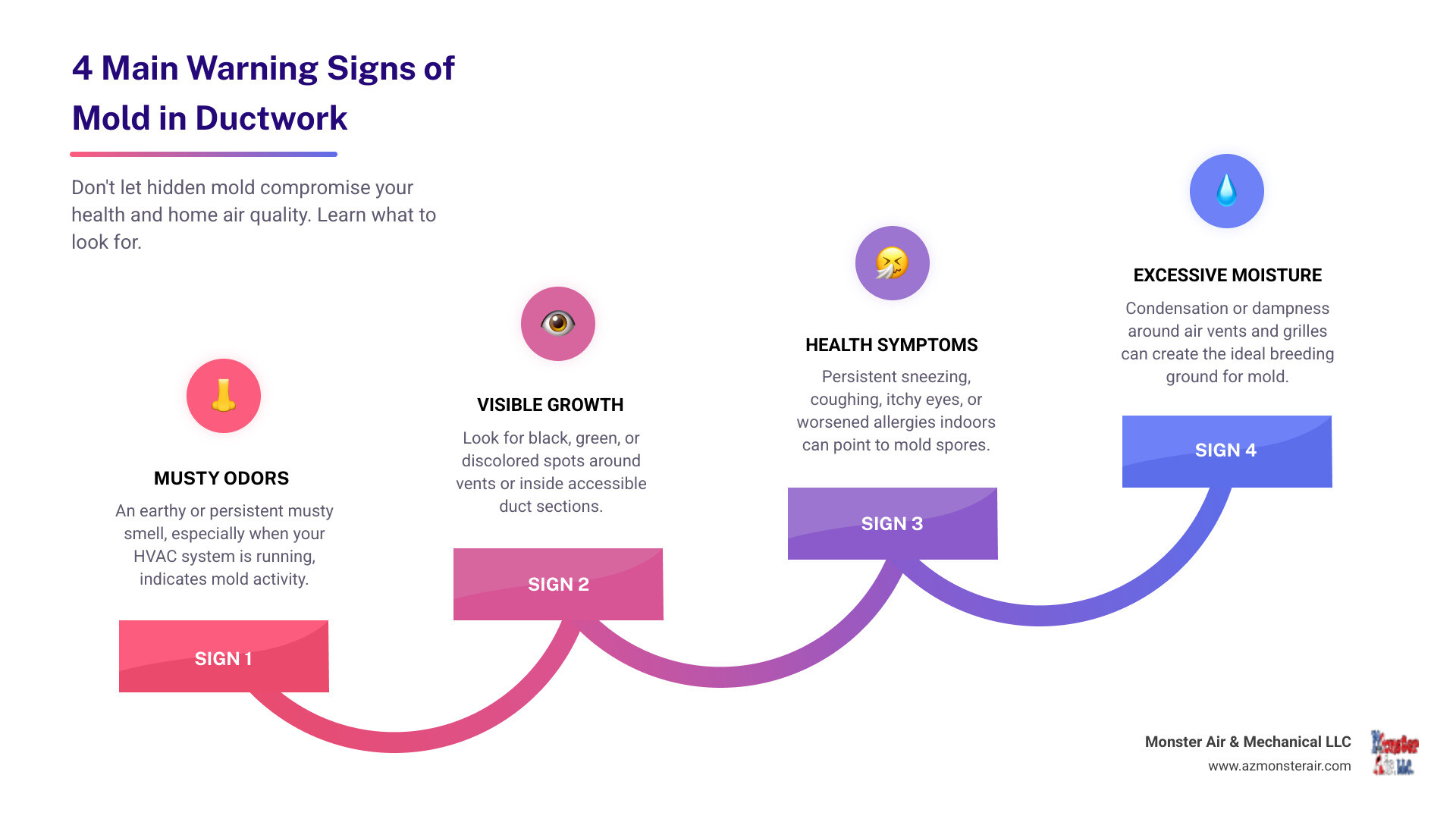
Spotting the Signs: How to Tell if You Have Mold in Your Air Ducts
When it comes to mold in ductwork, the clues are there if you know what to look for. The most telltale sign is a persistent musty, earthy smell that gets stronger when your heating or cooling kicks on. This odor comes from microbial Volatile Organic Compounds (mVOCs), which are gases released by growing mold. According to the EPA, this is exactly what mold smells like. If the smell comes from your vents, it's time to investigate.
Sometimes, you can see the mold. Use a flashlight to inspect your air vents and registers for black, green, or white spots. Also look for gray, brown, or yellowish staining around the vent openings, which indicates moisture has been present long enough for mold to grow.
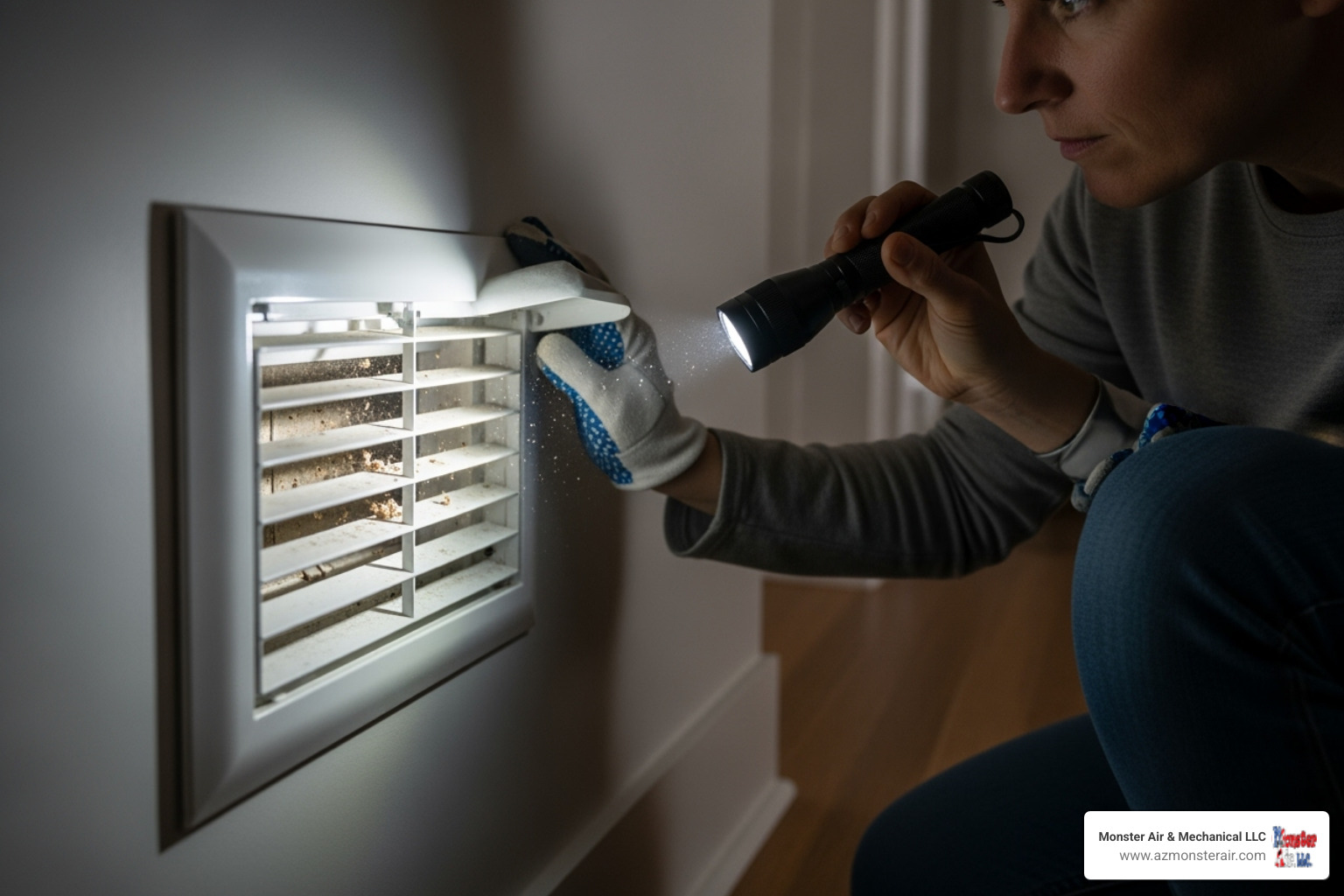
Moisture is another major red flag. Condensation around vents or dampness inside ducts creates the perfect breeding ground for mold, which can start growing in as little as 48 hours. Your body might also give you signals. If you experience health symptoms that worsen indoors, mold in ductwork could be the culprit.
Common Health Symptoms Linked to Ductwork Mold
When your HVAC system circulates mold spores, they can cause symptoms that mimic seasonal allergies or a persistent cold. The key difference is that these symptoms get worse when you're inside. You might experience sneezing, coughing, a runny nose, itchy eyes, or a scratchy throat. Some people develop skin rashes or headaches.
For those with existing respiratory conditions like asthma or COPD, the effects can be more serious, including shortness of breath, wheezing, or chest tightness. These are signs that mold exposure is affecting your respiratory system. If any of these symptoms of a mold allergy sound familiar, it's wise to investigate your indoor air quality. Our Indoor Air Quality Services can help identify and address these concerns.
Mold vs. Mildew in Your Ductwork
While often used interchangeably, mold and mildew are different fungi. Both thrive in damp conditions, but knowing the difference helps identify the problem.
| Feature | Mold | Mildew |
|---|---|---|
| Appearance | Fuzzy, slimy, or cotton-like texture. Usually black, green, red, blue, or yellow. Grows in irregular, spreading patches. | Flat and powdery or downy. Typically white, grey, or yellowish. Often appears in more uniform patches. |
| Texture | Can feel fuzzy, soft, or sometimes slimy to the touch. | Powdery or downy texture. |
| Location | Grows anywhere with moisture and organic material. Penetrates deep into surfaces. Common in damp, dark, hidden areas like inside ducts. | Tends to stay on surfaces, especially in humid spots like bathrooms or window sills. |
| Health Effects | Can cause serious health issues including respiratory problems, allergic reactions, and toxic effects (especially certain types like black mold). | Usually causes milder problems like coughing, headaches, or minor respiratory irritation. |
| Growth Pattern | Spreads deeply into materials, making it harder to remove completely. | Stays on the surface, generally easier to clean. |
In ductwork, you're usually dealing with mold, which penetrates materials and causes more significant health risks. Regardless of whether it's mold or mildew, any fungal growth in your air ducts indicates a moisture problem that needs to be fixed immediately.
The Root Causes and Hidden Risks of Mold in Ductwork
Mold in ductwork doesn't just appear; it needs specific conditions to grow. Understanding these causes is the first step toward fixing and preventing the problem.
The primary culprit is always moisture. Your ductwork can become a moisture trap when warm, humid air meets cold surfaces, like AC coils or uninsulated ducts, causing condensation. Other sources include leaky ducts that pull in humid air, leaks in the HVAC unit, overflowing drain pans, or nearby plumbing issues. If your home's humidity is consistently above 50-60%, the air itself can support mold growth.
An oversized HVAC system can worsen the problem by cooling the air too quickly without removing humidity. This, combined with poor ventilation, traps moisture and creates an ideal environment for mold. Mold also needs food, which it finds in the dust, dirt, pet dander, and other organic debris that accumulate in ducts. This is especially problematic for fiberglass insulation inside ducts, which becomes impossible to clean once it gets moldy.
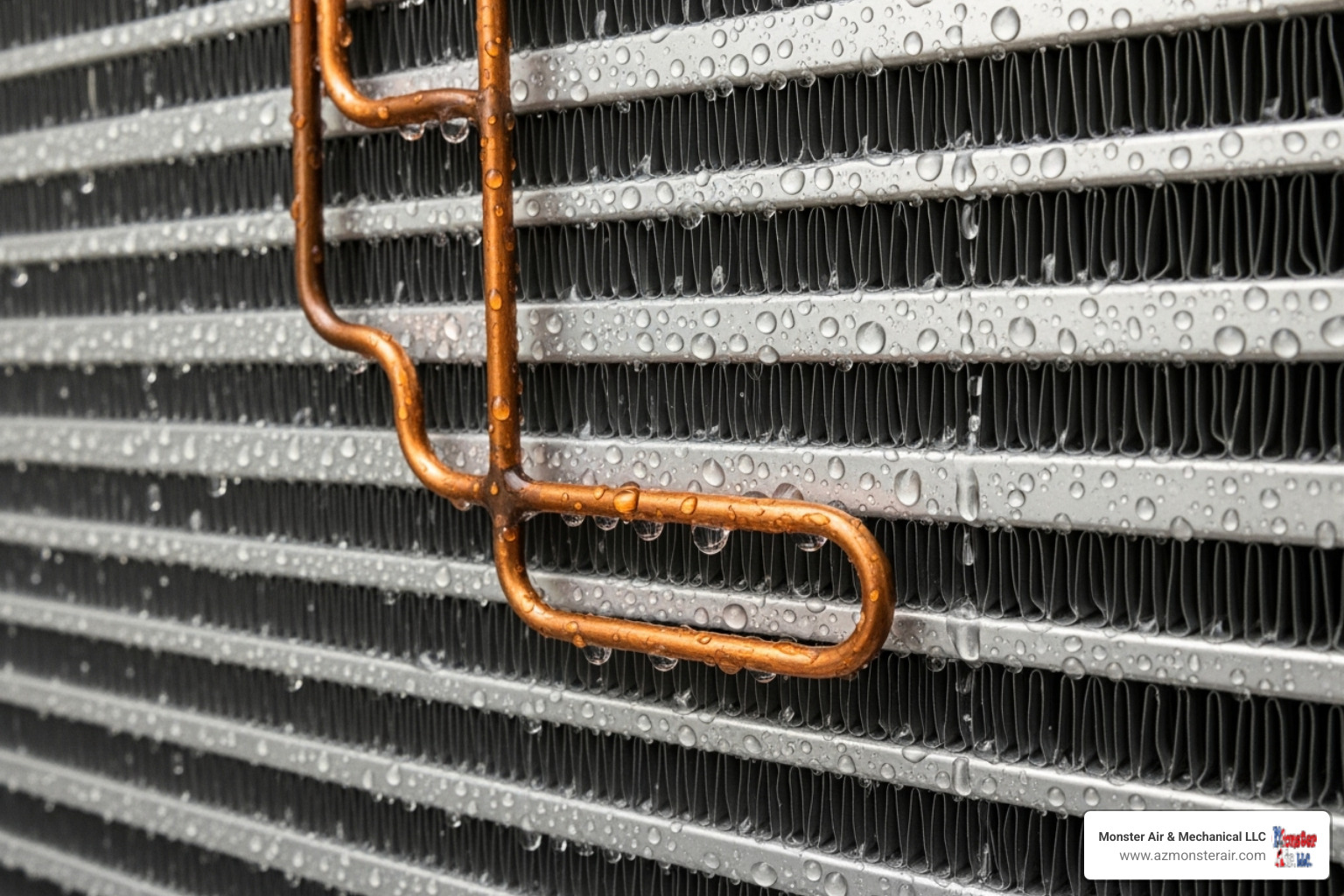
With moisture and food present, mold spores can begin growing within 48 hours.
How Mold in Ductwork Impacts Your Health and HVAC System
The consequences of mold in ductwork are serious, affecting both your family's health and your finances.
According to the EPA's research on mold and health, mold is a legitimate health hazard. Your HVAC system disperses spores, which act as allergens and irritants. For most, this causes allergy-like symptoms. For vulnerable individuals like children, the elderly, and those with asthma or COPD, exposure can trigger severe asthma attacks and chronic respiratory infections.
Mold also harms your HVAC system. Buildup creates airflow obstruction, forcing your system to work harder. This reduced HVAC efficiency leads to longer run times and increased energy bills. The constant strain causes premature wear on components, leading to potential system damage and costly repairs or early replacement. Our HVAC Services team often sees systems fail prematurely due to unaddressed mold issues.
Are Some Duct Types More Prone to Mold?
Yes, the material of your ducts matters. Sheet metal ducts are the most resistant, as their smooth, non-porous surface is difficult for mold to grow on and easier to clean.
Fiberglass duct board and internally lined ducts (metal ducts with fiberglass insulation inside) are highly susceptible. Fiberglass is porous, absorbing moisture and trapping debris. Once mold penetrates fiberglass, it's nearly impossible to clean. Both NADCA standards and the North American Insulation Manufacturers Association recommend that contaminated fiberglass be replaced, not cleaned.
Flexible ducts can also trap dust and moisture in their ridges. While some can be cleaned, heavily contaminated sections are often more cost-effective to replace. The key takeaway is that porous materials like fiberglass are mold magnets and typically require replacement once contaminated.
A Step-by-Step Guide to Removing Mold From Air Ducts
Finding mold in ductwork is concerning, but it's a fixable problem. However, this is not a DIY job. Attempting to remove mold yourself without proper containment can spread spores throughout your home, making the problem worse and increasing health risks.
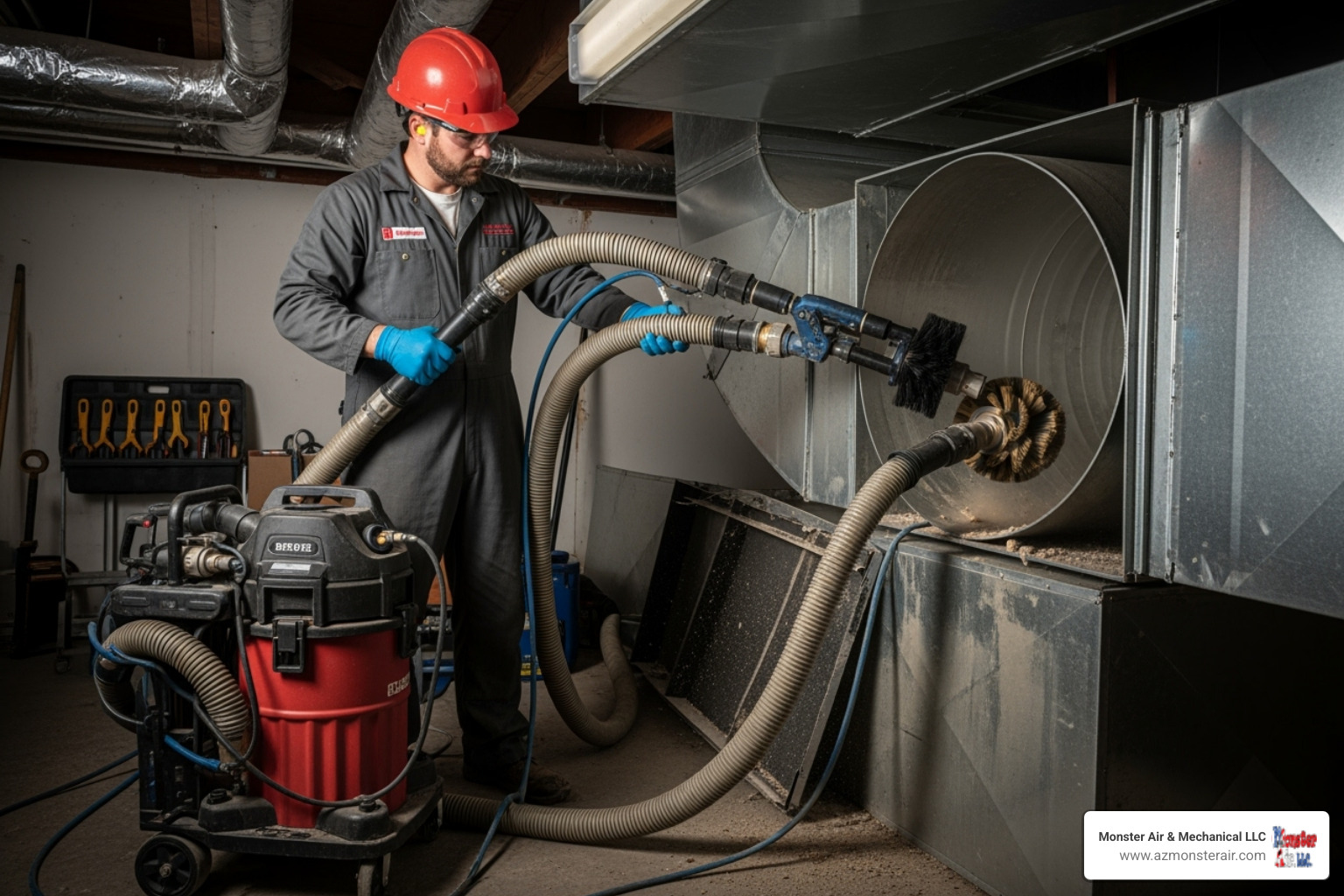
First, turn off your HVAC system to stop the circulation of contaminated air. Then, call a professional. At Monster Air & Mechanical LLC, we serve communities across Arizona, including Chandler, Florence, and Deer Valley, with the specialized equipment needed to safely eliminate mold in ductwork.
Step 1: Professional Inspection and Testing
What you see is often just the tip of the iceberg. A professional inspection reveals the full scope of the contamination. Our technicians conduct a thorough visual inspection of your entire HVAC system, including the furnace, evaporator coil, drain pan, and all accessible ductwork. We look for visible mold and, just as importantly, signs of moisture.
Identifying and fixing the moisture source is critical. Without water, mold can't grow, so if we don't fix the underlying leak, condensation, or humidity issue, the mold will return. In some cases, we may recommend professional mold testing (air or surface samples) to identify the type and concentration of mold, which helps guide our remediation strategy.
Step 2: The Professional Removal Process for mold in ductwork
Once we've inspected the system and identified the moisture source, we begin remediation. This professional process ensures all mold is eliminated safely.
- Containment: We seal off the HVAC system and vents with plastic sheeting to prevent spores from escaping into your home.
- Negative Air Pressure: Specialized equipment creates a vacuum, pulling any disturbed spores through HEPA filters and exhausting them outside.
- Agitation and Cleaning: We use high-powered brushes and air whips to dislodge mold and debris from the interior surfaces of the ducts.
- HEPA Vacuuming: As mold is dislodged, powerful HEPA-filtered vacuums capture the microscopic spores and debris, preventing them from re-entering your air.
- Antimicrobial Treatment: We apply an EPA-approved antimicrobial solution designed for HVAC systems to kill any remaining spores and inhibit future growth. All affected components, including coils and drain pans, are thoroughly cleaned and disinfected.
This comprehensive approach ensures mold in ductwork is completely eliminated.
Step 3: Addressing Mold on Insulated Ductwork
Insulated ductwork, like fiberglass duct board or internally lined ducts, presents a unique challenge. Because fiberglass is porous, mold penetrates deep into its fibers, making it impossible to clean effectively. Attempting to scrub it can release more spores and damage the insulation.
For this reason, when we find significant mold in ductwork involving fiberglass, we follow NAIMA recommendations and advise removal and replacement of the affected sections. This is the only way to ensure complete mold elimination and protect your health. If you suspect mold, don't wait. Schedule Professional Duct Cleaning and inspection with us for an honest assessment and a clear path forward.
Proactive Prevention: Keeping Your Air Ducts Mold-Free
After removing mold in ductwork, the goal is to ensure it never returns. The secret is controlling moisture, as mold cannot grow without it.
- Control Humidity: Keep indoor humidity below 50%. Use a dehumidifier in damp areas and ensure your HVAC system is properly sized to effectively remove humidity.
- Ensure Proper Ventilation: Use exhaust fans in bathrooms and kitchens to remove moisture-laden air before it can enter your ductwork.
- Schedule Regular HVAC Maintenance: During routine maintenance from our HVAC Services team, technicians clean evaporator coils and drain pans where mold often starts. We also ensure your condensate drain is clear to prevent water backup.
- Seal Duct Leaks: Gaps in ductwork can pull in humid air from attics or crawl spaces, causing condensation. Sealing these leaks, as recommended by Energy Star, prevents mold and improves energy efficiency.
Upgrading Your System for Cleaner Air
Strategic HVAC upgrades can make it nearly impossible for mold in ductwork to gain a foothold.
High-efficiency air filters with a MERV rating of 8-13 capture smaller particles, including mold spores and the dust they feed on. Remember to change your filter every 1-3 months. For maximum filtration, consider a HEPA Air Cleaning Installation.
UV light air purifiers are another powerful tool. Installed in your ductwork, these systems use UV-C light to kill mold spores, bacteria, and viruses on contact. Our UV Air Purifiers are especially effective at preventing mold growth on damp evaporator coils.
The Importance of Regular Duct Cleaning
Even with preventative measures, ducts accumulate dust and debris over time. This is why regular professional duct cleaning is essential for preventing mold in ductwork.
Think of it as removing the fuel for a potential fire. By cleaning out the dust, dander, and pollen that mold feeds on, we make it much harder for mold to establish itself. Most experts recommend professional duct cleaning every three to five years. However, you may need it more frequently if you have pets, allergies, or have recently renovated. Our Residential Duct Cleaning service is designed to keep your air clean and healthy.
Clean ducts mean less dust, fewer allergy symptoms, and peace of mind knowing your family is breathing healthy air.
Frequently Asked Questions about Mold in Ductwork
Homeowners often have questions when they suspect they have mold in ductwork. Here are answers to some of the most common ones.
Can I clean mold in my air ducts myself?
While tempting, DIY mold cleaning in ducts is risky. Without proper containment and equipment, you can easily spread mold spores throughout your home, turning a small problem into a widespread one. You might clean visible mold off a vent, but you can't reach the contamination deep within the system or inside porous materials like insulation. Professionals use HEPA vacuums and negative air machines to contain and remove spores safely. For mold in ductwork, calling a professional is the safest and most effective solution.
How does mold in air ducts affect my home's value?
Mold in ductwork can significantly impact your property's value. It can cause structural damage over time, leading to expensive repairs. In many states, you are legally required to disclose known mold issues to potential buyers. According to Angi, mold can damage your HVAC system and deter buyers, resulting in lower offers or difficulty selling. The good news is that professional remediation with proper documentation shows buyers the problem was handled correctly, which helps mitigate these concerns and protect your investment.
Will the musty smell go away after cleaning?
Yes, in most cases, professional mold remediation will eliminate the musty odor. That smell comes from compounds released by growing mold. However, for the smell to be gone for good, the moisture source must be fixed. If the underlying leak or humidity issue isn't resolved, the mold and the smell will return. After cleaning, it's also helpful to air out your home and clean porous items like carpets or curtains, which may have absorbed odors. If a musty smell persists after professional cleaning and fixing the moisture source, it could indicate another hidden mold problem elsewhere in your home that requires further investigation.
Ensure a Healthy Home with Professional Duct Cleaning
Your home should be a safe sanctuary, but mold in ductwork can compromise that. We've covered how to spot the warning signs, from musty smells to allergy symptoms, and explored the root causes like moisture and debris. We've also outlined the steps for effective removal and prevention, emphasizing why professional help is crucial.
Mold in ductwork is not a DIY project. Every time your HVAC system runs, it can circulate spores, affecting your family's health. Professional remediation ensures the job is done safely and thoroughly with specialized equipment like HEPA vacuums and EPA-approved treatments.
At Monster Air & Mechanical LLC, we've built our reputation on honesty, fast response times, and fair pricing. We serve communities across the Phoenix metro area, including Apache Junction, Chandler, and Florence, and are ready to restore your indoor air quality. We earn your trust by doing the job right.
Your family's health is too important to leave to chance. If you've noticed any warning signs of mold, don't wait for the problem to get worse.
Contact us for expert Duct Cleaning Services today, and let us help you breathe easier tomorrow.


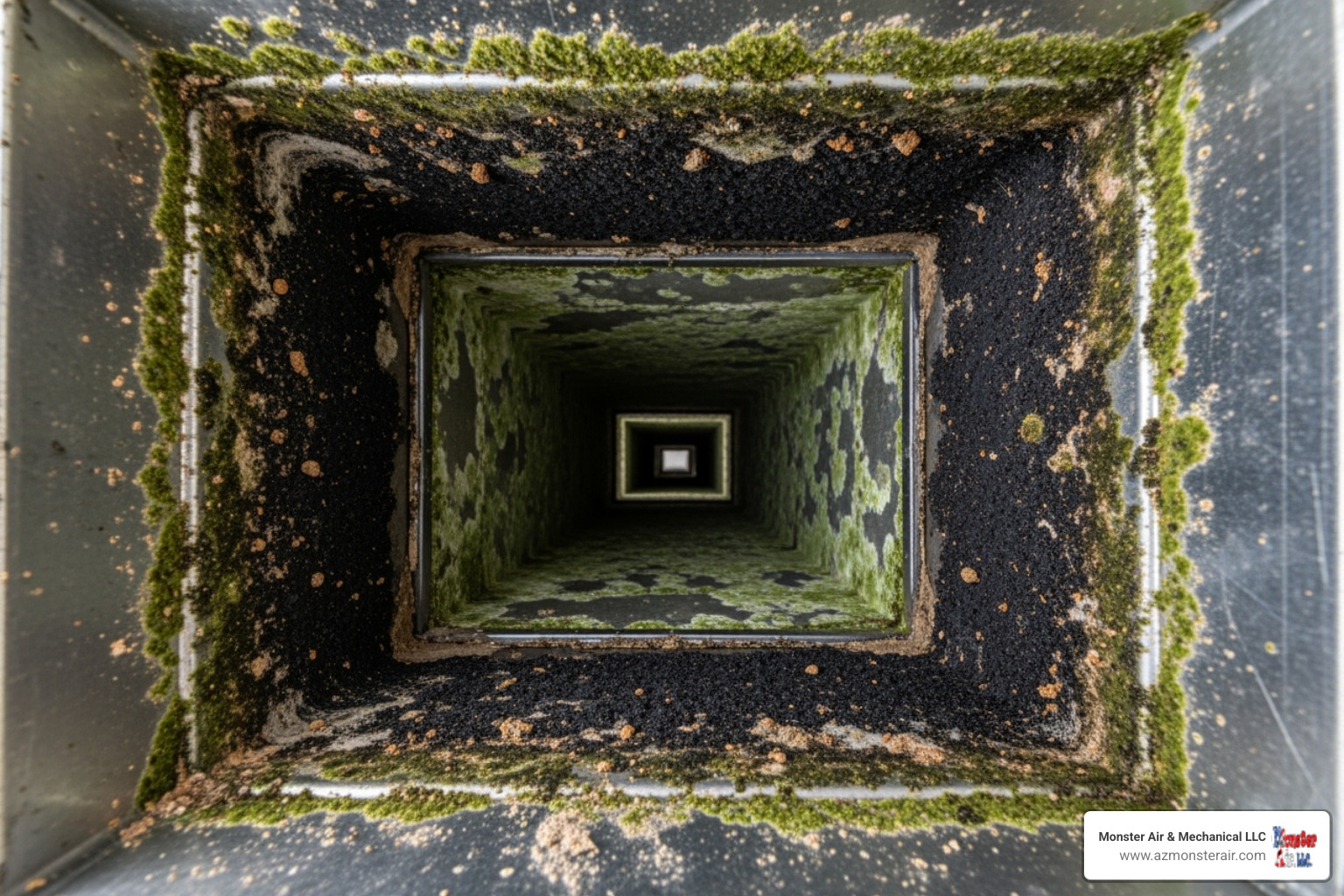

_11zon%20(1).webp)




